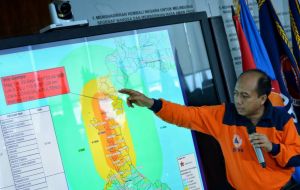MercoPress. South Atlantic News Agency
Quake and tsunami hit Indonesia searching for survivors and burying its dead
 Rescuers raced against the clock and a lack of equipment to save those still trapped in the rubble, with up to 60 people feared to be underneath one Palu hotel alone
Rescuers raced against the clock and a lack of equipment to save those still trapped in the rubble, with up to 60 people feared to be underneath one Palu hotel alone  “The casualties will keep increasing,” said spokesman Sutopo Purwo Nugroho. “We will start the mass burial of victims, to avoid the spread of disease.”
“The casualties will keep increasing,” said spokesman Sutopo Purwo Nugroho. “We will start the mass burial of victims, to avoid the spread of disease.” Mass graves were being readied for hundreds of victims of an Indonesian quake and tsunami on Monday as authorities battled to stave off disease and reach desperate people still trapped under shattered buildings. The death toll nearly doubled to 832 on Sunday but was expected to rise further after a disaster that has left the island of Sulawesi reeling.
The strong 7.5-magnitude quake struck Friday, toppling buildings and sending walls of seawater crashing into the city of Palu. Exhausted survivors scoured make-shift morgues for loved ones, and authorities struggled to dig out the living or assess the scale of the devastation in more remote regions beyond Palu. Grim warnings came that the eventual toll could reach thousands.
“The casualties will keep increasing,” said national disaster agency spokesman Sutopo Purwo Nugroho. “We will start the mass burial of victims, to avoid the spread of disease.”
Rescuers raced against the clock and a lack of equipment to save those still trapped in the rubble, with up to 60 people feared to be underneath one Palu hotel alone.
Rescuers said they heard voices and a child’s cries from under the rubble.
Desperate survivors turned to looting shops for basics like food, water and fuel as police looked on, unwilling or unable to intervene. The government was left with little option but to promise it would reimburse owners.
“Record everything taken, inventorize it. We will pay for it all,” said security minister Wiranto.
Indonesian President Joko Widodo visited the region Sunday afternoon, urging a “day and night” effort to save all those who can be saved. But disaster agency spokesman Nugroho indicated sheer power of will may not be enough.
“Communication is limited, heavy machinery is limited... it’s not enough for the numbers of buildings that collapsed,” he said. Still, as dire as the situation in Palu was, it was at least clear. In outlying areas, the fate of thousands is still unknown.
Indonesian Vice President Jusuf Kalla said the final death toll in the more remote regions could be in the “thousands” since many regions have still not been reached.
Indonesia’s Metro TV on Sunday broadcast aerial footage from a coastal community in Donggala, close to the epicenter of the quake. Some waterfront homes appeared crushed but a resident said most people fled to higher ground after the quake struck.
“When it shook really hard, we all ran up into the hills,” a man identified as Iswan told the TV.
Satellite imagery provided by regional relief teams showed severe damage at some of the area’s major ports, with large ships tossed on land, quays and bridges trashed and shipping containers thrown around. A double-arched yellow bridge had collapsed, its ribs twisted as cars bobbed in the water below.
A key access road had been badly damaged and was partially blocked by landslides.
The initial quake struck as evening prayers were about to begin in the world’s biggest Muslim majority country on the holiest day of the week.




Top Comments
Disclaimer & comment rulesCommenting for this story is now closed.
If you have a Facebook account, become a fan and comment on our Facebook Page!